Preparation method for scattering layer of dye-sensitized solar battery
A technology of solar cells and dye sensitization, which is applied in the field of preparation of photoanodes of dye-sensitized solar cells, can solve the problems of ineffective adsorption of dye molecules and low specific surface area, and achieve improved photoelectric conversion efficiency, high refractive index, and improved photoelectricity. The effect of absorbency
- Summary
- Abstract
- Description
- Claims
- Application Information
AI Technical Summary
Problems solved by technology
Method used
Image
Examples
Embodiment 1
[0032] Weigh 62 grams of sodium chloride to make 340 milliliters of solution, transfer the solution to an ice-water bath environment, add 10 milliliters of titanium tetrachloride dropwise, stir while adding, and obtain a colorless and uniform mixture after the addition is completed. solution. Transfer the mixed solution to a polytetrafluoroethylene-lined reactor for hydrothermal reaction, control the reaction temperature at 120°C, and hold for 12 hours. After the heat preservation is completed and cooled to room temperature, open the hydrothermal reactor and take out the Gallbladder, pour out the precipitate, wash 3 times to remove chloride ions and sodium ions, dry the pure precipitate to obtain large particle titanium oxide scattering microsphere powder. Get a small amount of powder and carry out X-ray diffraction (XRD) analysis, XRD result shows that titanium dioxide wherein is rutile phase, as figure 1 shown. figure 2 It is the field emission scanning electron microsco...
Embodiment 2
[0034]Weigh 41 grams of sodium chloride to make 340 ml of solution, transfer the solution to an ice-water bath environment, add 10 ml of titanium tetrachloride dropwise, stir while adding, and obtain a colorless and uniform mixture after the addition is completed. solution. Transfer the mixed solution to a polytetrafluoroethylene-lined reactor for hydrothermal reaction, control the reaction temperature at 120°C, and hold for 18 hours. After the heat preservation is completed and cooled to room temperature, open the hydrothermal reactor and take out the Gallbladder, pour out the precipitate, wash 3 times to remove chloride ions and sodium ions, dry the pure precipitate to obtain large particle titanium oxide scattering microsphere powder. Weigh 2 grams of large-particle scattering microspheres and transfer them to a mortar, add 8 grams of ethylcellulose terpineol solution with a mass fraction of 10% prepared in advance, and grind the mixture of the three for 2 hours to obtain a...
Embodiment 3
[0036] Weigh 41 grams of potassium chloride to make 340 milliliters of solution, transfer the solution to an ice-water bath environment, add 10 milliliters of titanium tetrachloride dropwise, stir while adding, and obtain a colorless and uniform mixture after the addition is completed. solution. Transfer the mixed solution to a polytetrafluoroethylene-lined reactor for hydrothermal reaction, control the reaction temperature to 150°C, and hold the heat for 12 hours. Gallbladder, pour out the precipitate, wash 3 times to remove chloride ions and potassium ions, dry the pure precipitate to obtain large particle titanium oxide scattering microsphere powder. Weigh 2 grams of large-particle scattering microspheres and transfer them to a mortar, add 8 grams of polyethylene glycol 20,000 aqueous solution with a mass fraction of 10% prepared in advance, and grind the mixture of the three for 1 hour to obtain a uniform slurry. Using the method of scraping coating, a layer of slurry is ...
PUM
| Property | Measurement | Unit |
|---|---|---|
| particle diameter | aaaaa | aaaaa |
| specific surface area | aaaaa | aaaaa |
| thickness | aaaaa | aaaaa |
Abstract
Description
Claims
Application Information
 Login to View More
Login to View More - R&D
- Intellectual Property
- Life Sciences
- Materials
- Tech Scout
- Unparalleled Data Quality
- Higher Quality Content
- 60% Fewer Hallucinations
Browse by: Latest US Patents, China's latest patents, Technical Efficacy Thesaurus, Application Domain, Technology Topic, Popular Technical Reports.
© 2025 PatSnap. All rights reserved.Legal|Privacy policy|Modern Slavery Act Transparency Statement|Sitemap|About US| Contact US: help@patsnap.com



